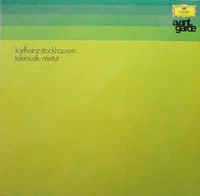Electronic Music Comes to Melbourne
In the 1950s, while Percy Grainger was relentlessly experimenting in Free Music in America, Australian composers Margaret Sutherland, Dorian Le Gallienne, Bruce Clarke, Felix Werder, Val Stephen and, later, Keith Humble, formed the core of Melbourne’s own New Music scene. Most of these Melbourne-based composers became interested in the new field of electronic music, inspired by recordings coming into Australia on LP albums.
German electronic composer Karlheinze Stockhausen, described as the ‘most controversial musical innovator of our time’, was hugely influential. His LP's, issued by Deutsche Grammophon, gave many Australian musicians the inspiration to explore the sonic possibilities of electronic music, often in combination with acoustic instruments. Stockhausen visited Australia for ten days in April 1970. He gave concert-lectures on electronic music around the country, including three programs in Wilson Hall, at the University of Melbourne. Delivered through a battery of speakers, Stockhausen’s electronic music ‘transformed Wilson Hall into a vast and sometimes terrifying acoustic cave’, according to a local newspaper. Performances included his Telemusik (1966).
American Milton Babbitt was also a source of inspiration, working out of the Columbia-Princeton Electronic Music Centre in the USA. Babbitt was hired as a consultant composer to work with the RCA Mark II Synthesizer. Babbitt was fascinated by the perceptual possibilities of the new world of electronic sound and human interaction, combining this with his deep interest in time and duration in music, and 12-tone serial composition.
Melbourne self-avowed 'amateur' musician Val Stephen heard recordings of Stockhausen issued by Deutsche Grammophon in 1959, and was immediately inspired to explore this type of ‘abstract’ music, creating his own electronic music studio at his home in Melbourne. Stephen started his studio with a twin-track tape recorder and musique concrète approach, recording and splicing natural sounds. Stephen was the first Australian to have electronic music released commercially on an international label, the Folkways label in the USA.
Bruce Clarke was also inspired by the electronic works of Stockhausen. Clarke’s Jingle Workshop in St Kilda was the first commercial electronic music studio in Australia, and he made the first Australian fully electronic jingle, for a cigarette commercial. The Autralian-produced LP, Artefacts of Australian Experimental Music: 1930 1972, features Clarke's composition called "Of Spiralling Why", one of the first completely electronic compositions produced in Australia. '"Of Spiralling Why" was commissioned for the Adelaide Arts Festival in 1966.
Clarke introduced composer Felix Werder to the use of electronics in the late 1960s. Werder acquired an EMS VCS3 synthesizer, and incorporated electronics into his performances. His group, Australia Felix, gave some of the earliest live electronic performances in Australia.
Keith Humble's return to Melbourne
The Grainger Museum became a centre of electronic activity in Melbourne when Keith Humble (1927-1995) was appointed as Senior Lecturer in Composition at the Conservatorium of Music, University of Melbourne, in 1966. Humble had returned to Melbourne after a decade working in the experimental hotbed of avant-garde music in Paris. He was deeply fascinated by early electronic music and electronic instruments that he had encountered in Europe, America and the UK. For the Utopian Humble, electronic music opened up a whole world of innovation and resistance to tradition. He also saw the great educational benefits, saying that ‘electronic equipment is a means of teaching the properties of music and of sounds which no conventional musical instrument can produce’.
Humble set up his office in the back of the Grainger Museum, and built up an electronic music studio over the next eight years that included the most cutting-edge synthesizers available in the period, sourced from EMS (Electronic Music Studios), London.








